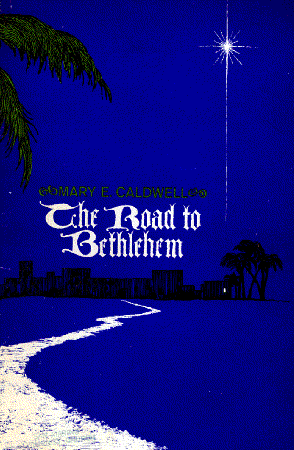

Simple costumes, a few props, and effective lighting may be used by the imaginative director to transform this cantata into an effective musical pageant pantomime. The aisles of the church sanctuary serve as the road(s) to Bethlehem, converging on two main focal points: the inn (steps leading to the platform) and the manger (the center of the platform). Rustic signposts, bearing the legend "To Bethlehem," may be placed at several places in the aisles pointing toward the inn A few rocks, shrubs, olive branches, or palms may be grouped around or near the signposts for further atmosphere. A decorative innkeeper's sign should mark the actual place of the inn. Scattered fireproof straw, a rude manger bed, and a low wooden bench or stool are sufficient for the stable room. The star of Bethlehem should be highlighted as the three kings approach. The two adult soloists are part of the pageant cast and sing from their respective places in the tableau or pantomime. The innkeeper will sing from among the group at the inn; Mary will sing her solo seated by the manger bed. The percussion instruments should be played by members of the group at the inn. To give the effect of coming from a distance, the camel bells should first be sounded at the rear of the sanctuary. Then as the three kings approach the manger scene, the bells should be played out of sight somewhere near the platform. Choir members should be robed and in their customary places for the entire presentation.
Part I: The Ancient RoadLights up full on the choir until " . . . to that first Christmas" (p. 6), then down gradually to dim, with spotlights up full on the inn and the innkeeper, who has entered quietly. Simultaneously, travelers in assorted costumes enter via aisles at the rear of the sanctuary as if going to Bethlehem. Some may stop to study the signposts; the first travelers should arrive just as Part I ends
. Part II At the InnThe innkeeper comes forward to meet his guests, who bargain with him and push and shove as if trying to find the best place to settle for the night. By the time the choir reaches " . . . the coaxing rhythm of the tambourines," he has arranged them in different groups on the steps. The guests respond to percussion effects by laughing and joking with one another. (Musicians and jugglers in colorful costumes can move from group to group, if desired.) As the knocking sounds (out of sight) at the door, they begin to show annoyance. Simultaneously, Mary and Joseph have moved quietly down the aisle to arrive at the inn As the indignation of the guests increases at the continuing sound of knocking, the innkeeper approaches Mary and Joseph at the foot of the steps. Spotlights are on these three figures as the innkeeper sings his solo (p. 17). At the conclusion of his solo, the innkeeper leads Mary and Joseph through the groups in the inn to the stable room beyond. The guests at the inn continue their merrymaking, regrouping so as to temporarily hide the figures at the manger scene. Suddenly the guests freeze into a tableau of suspended action as a single beam of light focuses on the manger scene (" . . . the gentle cry of a newborn child," p. 23). They spring into action immediately for the conclusion of the number. Lights down while the guests and innkeeper slowly depart.
Part III. The ShepherdsLights on the choir only as the shepherds start down the aisles, one or two pretending to play on shepherds' pipes or recorders. They stop to consider the signposts, then consult among themselves as if seeking directions. They stop at the foot of the steps as if puzzled by the darkened inn. As the choir sings " . . . but a soft light . . . " (p. 29), the lights switch to the manger scene. The shepherds kneel in worship at the manger and Mary sings her lullaby. At the conclusion, the shepherds exit up the aisles or offstage at the rear of the choir loft. Lights remain on the manger scene.
Part IV: The Three KingsCamel bells sound in the distance, the star of Bethlehem begins to glow brightly. The three kings traverse the aisles from the back, nodding in agreement as they approach the steps and point to the star. As they proceed up the steps and present gifts at the manger, the sound of the camel bells becomes louder. The kings remain in tableau until " . . . three stately kings riding back . . . " (p. 44), when they exit the same way they entered. The camel bells grow fainter as-they depart.
Part V: The Ancient Road TodayLights as in Part IV. As the choir sings " . . . to draw us like a magnet . . . " a variety of participants (different age groups, races, nationalities, contemporary dress, etc.) start down all aisles. They converge at the foot of the steps and at the words " . . . touch of hand in hand" (p. 50), they slowly join hands and, two by two, move to the manger until the entire group is a tableau of worship and adoration. Use the steps, too, if the platform is small. Fade out lights entirely at the conclusion, leaving only the manger and tableau in spotlight.